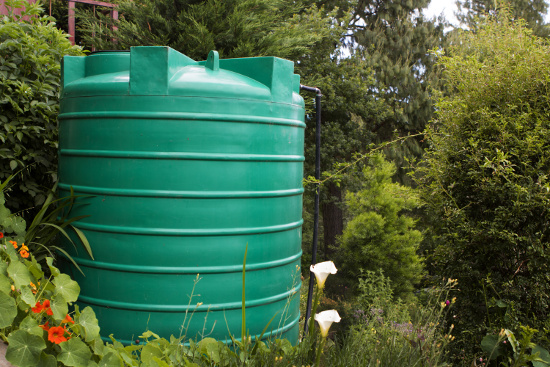Some homeowners think that a water tank’s color merely serves an aesthetic purpose. But the truth is, a water storage container’s hue can impact the fluid’s temperature and quality.

In choosing the right water tank for your home, it’s not enough to settle with the right color to match your property or your home’s entire look. It’s also vital to consider where you plan to place the tank and your home’s location. Read on to discover how to arrive at an intelligent decision about your container.
How Are Colored Water Tanks Made?
Buyers are faced with plenty of tank options when choosing the most common type; those made from polyvinyl chloride (PVC) or hard plastic. This water storage material is meant for commercial and residential uses and remains one of the most preferred materials to make a water tank.
Plastic tanks get their shades from pigments extracted from either natural minerals or synthetic chemicals. PVC tanks can get their hues by mixing these pigments with a resin that binds to the tanks during the molding process. The idea is to make these add-on pigments last long enough to resist discoloration when exposed to harsh elements. These chemicals last but may fade or break down with repeated exposure to direct sunlight.
1. Understand How Colors Impact Stored Water
Water tanks come in multiple shapes, sizes, and colors. Picking the right size requires buyers to consider the primary purposes of getting one and the household’s consumption needs. Selecting the right size requires property owners to consider the tank’s proposed location.
When it comes to choosing the right colors, it’s essential to understand that, in general, dark-toned items—whether it’s a water tank, a paint, or the roof—absorb more heat when exposed to the sun. Coloring agents present in these materials absorb the light from the sun and convert solar energy into heat. Hence, the tank’s color will primarily impact the water through heat and light.
How Does Heat Impact Water?
If you’re placing the tank in an unshaded area, expect the liquid coming from it to be warm. Unfortunately, bacteria and algae proliferate faster at high temperatures. If you’re planning to store water for drinking, it may be best to avoid getting a dark-colored container. Of course, you’d have to check your water pipes and source for these harmful microorganisms, too, to ensure your water is safe for drinking.
Conversely, lighter-hued tanks deflect heat better, ensuring that store fluids stay at environmental temperatures. Thus, if you’re placing the container under the heat of the sun, getting a light-colored tank could be a better choice.

How Does Light Impact Water?
Ideally, water must be stored away from direct sunlight in a cool and dark place. Earlier, you’ve understood how heat impacts kept water. Alongside heat, light can break down containers and trigger algae growth. Have you ever noticed mold and algae forming in clear, plastic water bottles that are left under direct or indirect sunlight? That’s light and heat working together to develop these unwanted and potentially hazardous organisms.
While ultraviolet light is often used to kill bacteria, it can also encourage algae growth by promoting photosynthesis, which feeds the algae. Light-hued water tanks allow more light to come through, making stored water vulnerable to algae growth. As you’d expect, dark-pigmented water tanks prevent the entry of light better than their bright-hued counterparts. However, your water source may also be already contaminated with algae, so do check for other possibilities before blaming your tank.
2. Know Where You’re Putting The Tank
As mentioned, stored water must be kept in low temperatures and dark areas where sunlight can’t reach. If you have a space in your property that ticks all the boxes, you don’t have to worry about heat and light negatively impacting the water quality in storage.
However, if you don’t have one, look at the environment around your tank’s proposed location. If it’s in an area directly exposed to sunlight, it’s better to a light-colored tank for reasons mentioned earlier.
3. Pick The Right Color
Now that you’ve understood how tank colors may impact water quality and have decided that you need light-colored water to keep your livestock’s drinking water cool, the next dilemma lies in picking the exact hue. The choice will depend on the owner’s color preference. Some go for blue to remind them of the sea—a primary water source. Others go for green to remind them of nature or match the surroundings.
The Bottom Line
While your preference must be considered in choosing the right water storage color, think about where you’re going to put the tank and how you’ll use the water store inside of it. Knowing these crucial issues can help keep you, your family, and your pets safe.
Remember that stored water has no shelf life and is meant to last a lifetime. However, how and where it’s stored considerably impacts its quality and shelf life.
